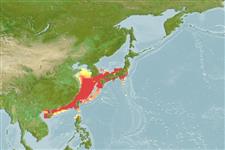Environment: milieu / climate zone / depth range / distribution range
Ecologia
marinhas associadas(os) a recifes; intervalo de profundidade 20 - 200 m (Ref. 5222). Tropical; 38°N - 18°N, 108°E - 142°E (Ref. 5222)
Northwest Pacific: Korea, Japan (north to Hegura-jima Island), China (south to Hong Kong and Hainan Island), and Taiwan.
Comprimento de primeira maturação / Tamanho / Peso / Idade
Maturity: Lm ?, range 54 - ? cm
Max length : 136 cm TL macho/indeterminado; (Ref. 89707); common length : 60.0 cm TL macho/indeterminado; (Ref. 9137); peso máx. publicado: 33.0 kg (Ref. 40637)
Espinhos dorsais (total): 11; Raios dorsais (total): 13-15; Espinhos anais 3; Raios anais : 8. Distinguished by the following characteristics: adults dark greyish brown; body covered with small pale grey spots forming short horizontal lines and mottled pattern; lower margin of the anal fin and lower corner of the caudal fin with white edge; juveniles pale yellowish brown, body with 6 irregular oblique dark bars containing irregular pale spots; elongate body, depth 3.0-3.6 times in SL; head length 2.3-2.5 in SL; convex interorbital area; angular preopercle, serrae at angle distinctly enlarged; inconspicuous dorsal spine on opercle; convex upper edge of operculum; small and subequal posterior and anterior nostrils; maxilla reaching past vertical at rear edge of eye, tiny embedded scales on maxilla; absence of step on ventral edge of maxilla; 2 rows of well-developed canines on midlateral part of lower jaw; caudal fin rounded; mid-lateral body scales ctenoid, without auxiliary scales on body (Ref. 089707).
Inhabits rocky reefs; also found on muddy grounds (Ref. 089707). Juveniles occur in shallow waters. Commercially cultured in Japan.
Ciclo de vida ou comportamento de acasalamento
Maturidade | Reprodução | Desova | Ovos | Fecundidade | Larvas
Heemstra, P.C. and J.E. Randall, 1993. FAO Species Catalogue. Vol. 16. Groupers of the world (family Serranidae, subfamily Epinephelinae). An annotated and illustrated catalogue of the grouper, rockcod, hind, coral grouper and lyretail species known to date. Rome: FAO. FAO Fish. Synop. 125(16):382 p. (Ref. 5222)
Status na Lista Vermelha da UICN (Ref. 130435)
Ameaça para os humanos
Harmless
Uso pelos humanos
Pescarias: espécies comerciais; Aquacultura: espécies comerciais; peixe esportivo: sim
Mais informação
ReferênciasAquaculturaPerfil para aquaculturaEstirpesGenéticaElectrophoresesHereditariedadeDoençasProcessamentoNutrientsConversão de massa
ColaboradoresFotosStamps, Coins Misc.SonsCiguateraVelocidadeTipo de nataçãoÁrea branquialOtólitosCérebrosVisão
Ferramentas
Relatórios especiais
Baixar XML
Fontes da internet
Estimates based on models
Preferred temperature (Ref.
123201): 17.7 - 23.7, mean 20.5 °C (based on 94 cells).
Índice de diversidade filogenética (Ref.
82804): PD
50 = 0.5000 [Uniqueness, from 0.5 = low to 2.0 = high].
Bayesian length-weight: a=0.01148 (0.00671 - 0.01964), b=3.06 (2.92 - 3.20), in cm total length, based on LWR estimates for this species & Genus-body shape (Ref.
93245).
Nível Trófico (Ref.
69278): 4.0 ±0.66 se; based on food items.
Resiliência (Ref.
120179): Muito baixo(a), tempo mínimo de duplicação da população maior que 14 anos (Preliminary K or Fecundity.).
Fishing Vulnerability (Ref.
59153): Very high vulnerability (82 of 100).
